
Home - Search - Browse - Alphabetic Index: 0- 1- 2- 3- 4- 5- 6- 7- 8- 9
A- B- C- D- E- F- G- H- I- J- K- L- M- N- O- P- Q- R- S- T- U- V- W- X- Y- Z
Tubsat
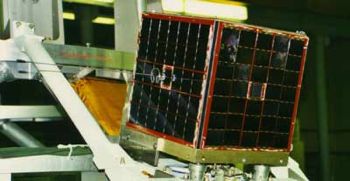 Maroc-Tubsat Credit: Manufacturer Image |
AKA: Maroc;Technical University of Berlin Satellite. Status: Operational 1991. First Launch: 1991-07-17. Last Launch: 2015-09-28. Number: 8 . Gross mass: 45 kg (99 lb). Height: 0.50 m (1.64 ft).
Each satellite could be oriented in three axes and carried an imaging payload. The series also included two Tubsat-N 'nanosatellite' Tubsats.
More at: Tubsat.
| Tubsat A Technology satellite for TU Berlin, Germany. Launched 1991. |
| Tubsat B Technology satellite for TU Berlin, Germany. Launched 1994. |
| DLR-Tubsat Earth Observing satellite built by TU-Berlin for DLR, Germany. Launched 1999. Used the Tubsat-C Bus bus. |
| Maroc-Tubsat (Zarkae Al Yamama) Null |
| LAPAN-Tubsat / LAPAN A1 Null |
Family: Communications, Communications technology sat, Earth, Sun synchronous orbit, Technology. Country: Germany. Spacecraft: Orbcomm, Tubsat. Launch Vehicles: Tsiklon, R-29, Tsiklon-3, Ariane, Ariane 4, Ariane 40, PSLV, Zenit-2, Shtil'-1, PSLV-XL. Launch Sites: Baikonur, Plesetsk, Barents Sea Launch Area, Kourou, Sriharikota, Baikonur LC45/1, Kourou ELA2, Sriharikota PSLV, Sriharikota SLP. Agency: TUB. Bibliography: 2, 276, 279, 296, 4, 552, 554, 568, 6, 13316.
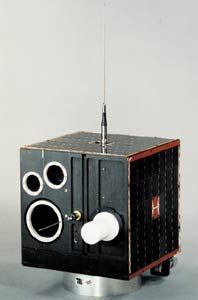 | DLR-Tubsat Credit: Manufacturer Image |
 | Tubsat-A Credit: Manufacturer Image |
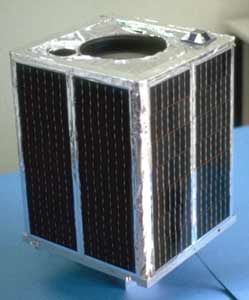 | Tubsat-B Credit: Manufacturer Image |
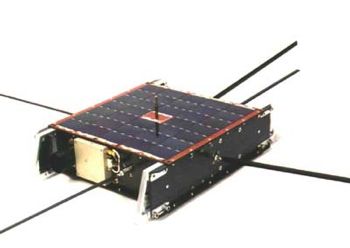 | Tubsat-N Credit: Manufacturer Image |
 | Tubsat-N1 Credit: Manufacturer Image |
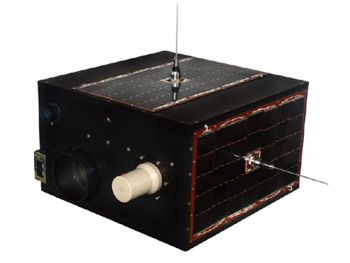 | LAPAN Tubsat Credit: Manufacturer Image |
1991 July 17 - . 01:46 GMT - . Launch Site: Kourou. Launch Complex: Kourou ELA2. LV Family: Ariane. Launch Vehicle: Ariane 40.
- Tubsat-A - .
Payload: Tubsat A. Mass: 38 kg (83 lb). Nation: Germany.
Agency: Orbcomm.
Program: Tubsat.
Class: Technology.
Type: Communications technology satellite. Spacecraft: Tubsat.
USAF Sat Cat: 21577 . COSPAR: 1991-050D. Apogee: 772 km (479 mi). Perigee: 762 km (473 mi). Inclination: 98.50 deg. Period: 100.20 min.
Tubsat-A was the first satellite built at Germany's Technical University of Berlin was intended primarily to test attitude control subsystems and give students practice in the design, construction and operation of a satellite. Tubsat-A was launched piggyback with the first ERS mission, and because of it's near polar orbit, the spacecraft became an important communications tool for arctic and Antarctic expeditions. The spacecraft also acted as a testbed for some industry technology including GaAs cells and a transputer. Payload: Star Sensor, Sun Sensor, 3-Axis Magnetic Field Sensor, Magnetorquer, Store & Forward Communication. Dimensions: 38x38x38 cm. Mass: 35 kg. Still in operation as of 2003.
1994 January 25 - . 00:25 GMT - . Launch Site: Plesetsk. LV Family: R-36. Launch Vehicle: Tsiklon-3.
- Tubsat-B - .
Mass: 40 kg (88 lb). Nation: Germany.
Agency: TUB.
Program: Tubsat.
Class: Technology.
Type: Navigation technology satellite. Spacecraft: Tubsat.
USAF Sat Cat: 22970 . COSPAR: 1994-003B. Apogee: 1,210 km (750 mi). Perigee: 1,184 km (735 mi). Inclination: 82.60 deg. Period: 109.40 min.
Following the success of the magnetic torque attitude control system that flew on Tubsat-A, researchers and students at Germany's Technical University of Berlin constructed Tubsat-B to test and demonstrate attitude control with a star sensor and three reaction wheels. An on-board 1m telescope was used for astronomy and for Earth observation at 10m resolution. Dimensions of the satellite were 38x38x50 cm, mass 40 kg. Unfortunately communications with the satellite were lost after 39 Days
1998 July 7 - . 03:15 GMT - . Launch Site: Barents Sea Launch Area. Launch Pad: 69.5 N x 34.2 E. Launch Platform: K-407. LV Family: R-29. Launch Vehicle: Shtil'-1.
- Tubsat-N - .
Mass: 8.00 kg (17.60 lb). Nation: Germany.
Agency: VMF.
Manufacturer: TuB.
Program: Tubsat.
Class: Communications.
Type: Civilian store-dump communications satellite. Spacecraft: Tubsat.
Decay Date: 2002-04-23 . USAF Sat Cat: 25389 . COSPAR: 1998-042A. Apogee: 776 km (482 mi). Perigee: 400 km (240 mi). Inclination: 78.90 deg. Period: 96.40 min.
The first satellite launch from a submarine. The Shtil-1 launch vehicle was a converted Makeyev R-29RM SLBM. The satellite payload was placed in the standard re-entry vehicle. The launch platform was the K-407 Novomoskovsk, a 667BDRM Delfin class submarine of the Russian Northern Fleet 3rd Flotilla. The launch was made from a firing range in the Barents Sea off the coast of the Kolskiy Peninsula, at 35.3 deg E 69.3 deg N. The payloads were the Tubsat-N and Tubsat-N1 `nanosatellites'. Tubsat-N entered a 400 x 776 km x 78.9 deg orbit. Both carried small store-forward communications payloads used to keep track of transmitters placed on vehicles, migrating animals, and marine buoys. They are owned, operated and built by the Technische Universitat Berlin (TUB). Tubsat-N was the larger of the pair, with dimensions of 32x32x10.4 cm and a mass of 8.5 kg.
- Tubsat-N1 - .
Mass: 3.00 kg (6.60 lb). Nation: Germany.
Agency: VMF.
Manufacturer: TuB.
Program: Tubsat.
Class: Communications.
Type: Civilian store-dump communications satellite. Spacecraft: Tubsat.
Decay Date: 2000-10-21 . USAF Sat Cat: 25390 . COSPAR: 1998-042B. Apogee: 776 km (482 mi). Perigee: 400 km (240 mi). Inclination: 78.90 deg. Period: 96.30 min.
The dual Tubsat-N/Tubsat-N1 repersented the Technical University of Berlin's first Nanosatellite project. Tubsat-N1 measured 32x32x3.4cm and had a mass of 3 kg. The technology demonstrator satellite provided store and forward communications and conducted attitude control experiments.
1999 May 26 - . 06:22 GMT - . Launch Site: Sriharikota. Launch Complex: Sriharikota PSLV. Launch Vehicle: PSLV.
- DLR-Tubsat - .
Mass: 45 kg (99 lb). Nation: Germany.
Agency: DLR.
Class: Earth.
Type: Seismology satellite. Spacecraft: Tubsat.
USAF Sat Cat: 25757 . COSPAR: 1999-029B. Apogee: 733 km (455 mi). Perigee: 712 km (442 mi). Inclination: 98.60 deg. Period: 99.20 min.
DLR-Tubsat carried on the experimental work of Tubsat-A and -B. The satellite measured 32x32x32 cm and had a mass of 44.8 kg. The dechnology demonstrator conducted earth observation with 6 m resolution and conducted attitude control experiments. It was still in operation as of 2003.
2001 December 10 - . 17:18 GMT - . Launch Site: Baikonur. Launch Complex: Baikonur LC45/1. LV Family: Zenit. Launch Vehicle: Zenit-2.
- Maroc-Tubsat - .
Mass: 45 kg (99 lb). Nation: Morocco.
Agency: RAKA.
Manufacturer: TuB.
Class: Technology.
Type: Navigation technology satellite. Spacecraft: Tubsat.
USAF Sat Cat: 27004 . COSPAR: 2001-056D. Apogee: 1,014 km (630 mi). Perigee: 985 km (612 mi). Inclination: 99.20 deg. Period: 105.10 min.
Maroc-Tubsat was built by the Technical University of Berlin for the Centre Royal de Teledetection Spatiale, Morocco, and had a mass of 47 kg. It carried an imager and a store-forward communications test payload. The satellite measured 32x34x36,2 cm and was still in operation as of 2003.
2007 January 10 - . 04:16 GMT - . Launch Site: Sriharikota. Launch Complex: Sriharikota PSLV. Launch Vehicle: PSLV.
- LAPAN Tubsat - . Mass: 56 kg (123 lb). Nation: Indonesia. Agency: ISRO. Class: Technology. Type: Navigation technology satellite. Spacecraft: Tubsat. USAF Sat Cat: 29709 . COSPAR: 2007-001A. Apogee: 638 km (396 mi). Perigee: 620 km (380 mi). Inclination: 97.90 deg. Period: 97.30 min. Experimental satellite developed with assistance from TUB (Berlin Technical University. It carried a 5-meter-resolution surveillance camera..
2015 September 28 - . 04:30 GMT - . Launch Site: Sriharikota. Launch Complex: Sriharikota SLP. Launch Pad: Sriharikota FLP. LV Family: PSLV. Launch Vehicle: PSLV-XL.
- LAPAN-A2 - . Mass: 68 kg (149 lb). Nation: Indonesia. Class: Technology. Type: Technology satellite. Spacecraft: Tubsat. USAF Sat Cat: 40931 . COSPAR: 2015-052B. Apogee: 650 km (400 mi). Perigee: 631 km (392 mi). Inclination: 6.00 deg. Period: 97.54 min. Indonesian microsatellite; carried an AIS (Automatic Identification System) to identify ships in Indonesia waters, a video camera, and a payload for disaster management by amateur radio operators..
Back to top of page
Home - Search - Browse - Alphabetic Index: 0- 1- 2- 3- 4- 5- 6- 7- 8- 9
A- B- C- D- E- F- G- H- I- J- K- L- M- N- O- P- Q- R- S- T- U- V- W- X- Y- Z
© 1997-2019 Mark Wade - Contact
© / Conditions for Use